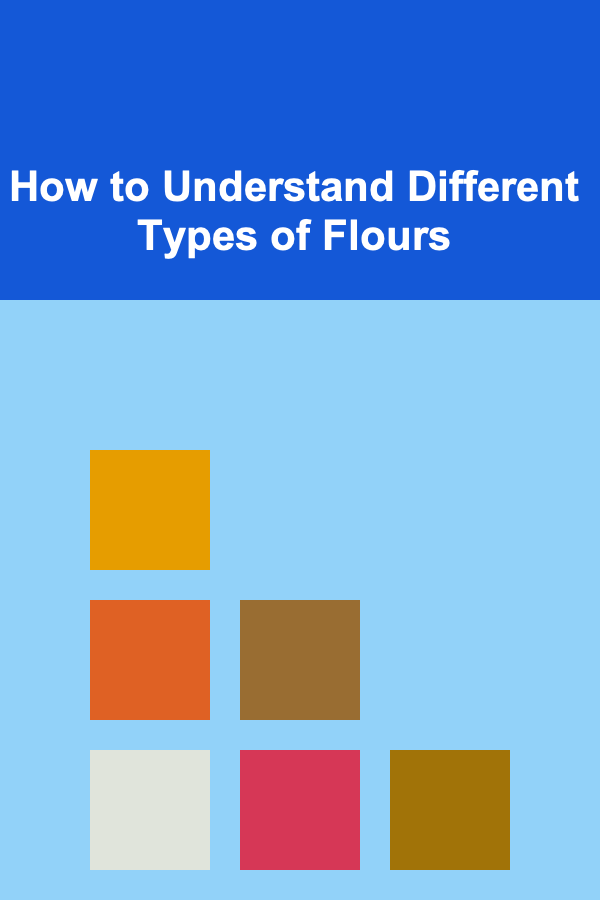
How to Understand Different Types of Flours
ebook include PDF & Audio bundle (Micro Guide)
$12.99$10.99
Limited Time Offer! Order within the next:

Flour is a fundamental ingredient in many culinary traditions, serving as the base for a multitude of baked goods, from bread and cakes to pastries and pastas. Despite its common use, not all flours are created equal. The differences in texture, color, and taste can vary significantly depending on the type of flour, the wheat variety, and how it is processed. Understanding these variations can make all the difference in the outcome of your recipes.
In this article, we will explore the different types of flours, breaking them down into categories, discussing their uses, and offering advice on how to choose the right flour for your needs. Whether you are a seasoned baker or a home cook just beginning to explore the world of flour, this guide will give you the insight needed to make informed choices in the kitchen.
What Is Flour?
Flour is typically a fine powder made by grinding grains, beans, nuts, or seeds. The most common type of flour is wheat flour, which is milled from wheat kernels. Wheat itself contains several key components: the bran (the outer shell), the germ (the nutrient-rich core), and the endosperm (the starchy center). The way the wheat is milled and processed affects the final flour product.
While wheat flour is the most widely known, there are numerous other types of flour made from different grains and plants, each with unique properties and uses. These include corn flour, rice flour, oat flour, and many more. Understanding these distinctions will help you choose the right flour based on your recipe requirements.
The Basics of Wheat Flour
Wheat flour is the most common type of flour used in baking and cooking. It comes in various forms, each suited to different purposes. The two main factors that determine the properties of wheat flour are the protein content (gluten) and the type of wheat used. Gluten is a protein found in wheat that gives dough its elasticity and helps it rise during baking.
1. All-Purpose Flour
All-purpose flour (APF) is the most commonly used flour in homes and bakeries. It is made from a blend of hard and soft wheat and typically has a moderate protein content of around 10-12%. This gives it a balanced ability to form gluten, making it suitable for a wide range of recipes, including bread, cakes, cookies, muffins, and pancakes.
- Uses: General baking, such as cakes, cookies, muffins, pancakes, and even some types of bread.
- Substitutes: Bread flour (for more structure) or cake flour (for a lighter texture), depending on the recipe.
2. Bread Flour
Bread flour is made from hard wheat and has a higher protein content (typically 12-14%) than all-purpose flour. The extra protein allows for the development of more gluten, which is essential for creating chewy and airy bread. This type of flour helps bread rise effectively and gives it a chewy texture.
- Uses: Bread, pizza dough, bagels, and other baked goods requiring structure and chewiness.
- Substitutes: All-purpose flour (although the result may be denser) or a blend of all-purpose flour and vital wheat gluten.
3. Cake Flour
Cake flour is made from soft wheat and has a lower protein content (around 7-9%), making it ideal for creating light, delicate baked goods. The lower protein content results in less gluten formation, which allows for a tender crumb in cakes, cupcakes, and pastries.
- Uses: Cakes, cupcakes, cookies, and other baked goods requiring a soft, delicate texture.
- Substitutes: All-purpose flour (with a small amount of cornstarch added) to mimic the softness of cake flour.
4. Pastry Flour
Pastry flour is another soft wheat flour, with a protein content of around 8-9%. It is slightly higher in protein than cake flour but still lower than all-purpose flour. This makes it perfect for pastries, pie crusts, and cookies, where a flaky or tender texture is desired.
- Uses: Pie crusts, tarts, cookies, and other delicate pastries.
- Substitutes: A combination of cake flour and all-purpose flour.
5. Whole Wheat Flour
Whole wheat flour is made from the entire wheat kernel, including the bran, germ, and endosperm. Because it retains the outer layers of the wheat kernel, it is higher in fiber and nutrients compared to white flour. The higher fiber content gives it a denser texture and a richer flavor.
- Uses: Whole wheat bread, muffins, pancakes, and other baked goods that benefit from a hearty, nutty flavor.
- Substitutes: All-purpose flour or bread flour (but the texture and flavor will be different).
6. Self-Rising Flour
Self-rising flour is a mixture of all-purpose flour, baking powder, and salt. It is typically used in recipes that require leavening agents, such as biscuits, pancakes, and some types of cakes. Self-rising flour eliminates the need for adding baking powder and salt separately in the recipe.
- Uses: Biscuits, scones, pancakes, and other baked goods that require a quick leavening agent.
- Substitutes: All-purpose flour combined with baking powder and salt.
Specialty Flours
In addition to standard wheat flours, there are many specialty flours that cater to different dietary needs or are used in specific cuisines. These flours can offer unique flavors, textures, and nutritional profiles.
1. Gluten-Free Flours
For those with gluten sensitivities or celiac disease, gluten-free flours are a necessity. These flours are made from grains or other plants that do not contain gluten. Common gluten-free flours include:
- Rice Flour: A fine, white flour made from ground rice. Often used in combination with other gluten-free flours for texture and structure.
- Almond Flour: Made from finely ground almonds, almond flour is commonly used in gluten-free and low-carb baking. It adds a nutty flavor and moistness to baked goods.
- Coconut Flour: Made from dried coconut meat, coconut flour is highly absorbent and often requires more liquid in recipes. It is used in gluten-free, paleo, and low-carb baking.
- Sorghum Flour: A gluten-free flour made from the whole sorghum grain, which adds a mild, slightly sweet flavor to baked goods.
- Tapioca Flour: Derived from the root of the cassava plant, tapioca flour is often used as a thickening agent in gluten-free recipes.
Gluten-free flours can be more challenging to work with, as they do not have the gluten necessary for structure. Often, a combination of several gluten-free flours is used in recipes to mimic the texture of wheat flour.
2. Corn Flour and Cornmeal
Corn flour and cornmeal are made from ground corn. Corn flour is a fine powder, while cornmeal has a coarser texture. Both are often used in cooking and baking, particularly in traditional dishes like cornbread and tortillas.
- Uses of Corn Flour: Sauces, soups, and gluten-free baking.
- Uses of Cornmeal: Cornbread, muffins, and crusts for fried foods.
3. Rice Flour
Rice flour is commonly used in Asian cuisines, especially in noodles, rice cakes, and various desserts. It is a fine, white flour that is often combined with other flours in gluten-free baking.
- Uses: Asian dumplings, rice noodles, and gluten-free baked goods.
4. Oat Flour
Made from ground oats, oat flour is a gluten-free option that provides a slightly sweet, nutty flavor. It is often used in cookies, muffins, and pancakes. Because oats are naturally low in gluten, oat flour is often used in combination with other gluten-free flours to improve texture and structure.
- Uses: Gluten-free baking, particularly in cookies, muffins, and pancakes.
5. Chickpea Flour (Garbanzo Bean Flour)
Chickpea flour is made from ground dried chickpeas and is commonly used in Middle Eastern, Indian, and Mediterranean cooking. It is rich in protein and fiber, making it a nutritious addition to savory dishes and baked goods.
- Uses: Falafel, chickpea pancakes, savory baked goods, and gluten-free baking.
6. Teff Flour
Teff flour is made from the tiny seeds of the teff plant, native to Ethiopia. It is a staple in Ethiopian cuisine, particularly in the making of injera, a type of flatbread. Teff flour is gluten-free and high in protein, iron, and calcium.
- Uses: Injera, gluten-free baking, and pancakes.
How to Choose the Right Flour
Choosing the right flour can be confusing, especially when there are so many options available. Here are a few tips to help you make the best choice:
- Consider the Recipe Type: If you are baking bread or pizza, choose bread flour for a chewy texture. For cakes and pastries, go for cake flour or pastry flour for a tender crumb.
- Check Protein Content: Higher protein flours like bread flour create a chewy texture, while lower protein flours like cake flour create a lighter, more delicate result.
- Dietary Restrictions: If you are following a gluten-free diet, consider using a combination of gluten-free flours, such as rice flour, almond flour, or oat flour.
- Flavor Preferences: Different flours have distinct flavors. Whole wheat flour has a nutty flavor, while rice flour and oat flour are milder.
Conclusion
Understanding the different types of flours and their characteristics is essential for successful baking and cooking. By choosing the right flour for your recipe, you can achieve the desired texture, flavor, and structure in your baked goods. Whether you're baking a simple loaf of bread or experimenting with gluten-free alternatives, the right flour can make all the difference in your kitchen.

Beginner's Guide to DIY Gardening and Landscaping: Tips for a Beautiful Yard
Read More
How to A/B Test Influencer Content for Better Campaign Performance in Dropshipping
Read More
How to Decorate Your Home for Spring with Budget-Friendly Ideas
Read More
How to Make Your Home Feel More Expensive with Lighting
Read More
How to Make Your Rental Property More Appealing to Renters
Read More
Strategic Healthcare Leadership: A Guide for Administrators
Read MoreOther Products

Beginner's Guide to DIY Gardening and Landscaping: Tips for a Beautiful Yard
Read More
How to A/B Test Influencer Content for Better Campaign Performance in Dropshipping
Read More
How to Decorate Your Home for Spring with Budget-Friendly Ideas
Read More
How to Make Your Home Feel More Expensive with Lighting
Read More
How to Make Your Rental Property More Appealing to Renters
Read More